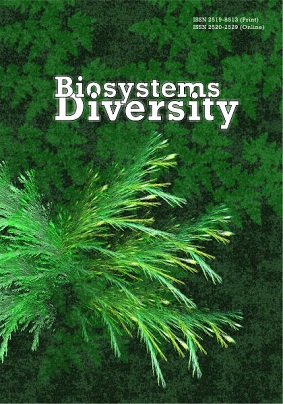Зміна показників структури однорічного пагона Quercus rubra в умовах антропогенного навантаження
Changes in the structural indices of annual shoots of Quercus rubra under anthropogenic impact
Author(s): A. P. Kryvoruchko, V. P. BessonovaSubject(s): Environmental Geography, Human Ecology, Environmental interactions
Published by: Дніпропетровський національний університет імені Олеся Гончара
Keywords: red oak; anthropogenic impact; characteristics; periderm; primary cortex and bark; wood tissue; shoot;
Summary/Abstract: Air pollution is one of the important problems of large cities. In connection with this, comprehensive study of the mechanisms of the corresponding reactions of tree species, introduced in the process of landscaping, to various environmental factors is required. The aim of this study is to analyze the influence of urban technogenic environmental pollution on the anatomical characteristics of Quercus rubra Linnaeus, 1753 annual shoots. The object of research was 35-year-old plants of Q. rubra, which grew in a non-polluted site (conditionally clean zone), the Botanical Garden of DNU (plot 1) and in a polluted site (roadside planting) (plot 2) of Dnipro City. Industrial emissions of the city’s western, northeastern and northwest industrial complexes also have an effect on plants, depending on the wind direction. For anatomical research, the annual shoots were taken at the tips of the vegetation from the south-eastern side of the model trees at a height of 2 m and fixed in 70% alcohol. Cross sections were made at a distance of 1 cm from the beginning of growth. Phloroglucine was used to dye the cells. The influence of industrial and automobile emissions on the structural parameters of Q. rubra shoots was investigated. We established that the membrane thickened evenly in both control and experimental plants. Cork thickness of Q. rubra shoots, growing in the roadside plantation was higher than in plants of the Botanical Garden by 57.5%. Increasing its thickness in plants exposed to atmospheric air pollution has an adaptive value. Q. rubra shoots have a tabulate type of collenchyma, the tangent walls of whose cells thicken. The collenchyma cells of the control variant of shoots are larger. This tissue was thicker in Q. rubra shoots from the polluted site by 26.8% compared to those from the non-polluted zone. The parenchyma cells of the primary cortex were large and contained chloroplasts. The thickness of this histological element on the shoot circumference varied considerably both in the control and experimental variants, which is the result of its uneven formation. This is due to the fact that the shape of the shoot core resembles a pentagonal star, and the layers of phloem and xylem tissues repeat its shape. The thickness of each of them in the cross section of the shoots in various places varied little, while the parenchyma of the primary cortex above the ray cells was narrower, and between them was broader, as a result the thickness of the shoots was aligned in a circle. In areas where the parenchyma of the primary cortex was narrower, it was better developed in the shoots of experimental plants than the control ones, but where its layer was thicker, it was more developed in plants of the control variant. The diameter of the primary cortex in the shoots of the experimental variant in its narrower parts was 120.5% of the control, and in the broader – 87.6%, which is due to unequal changes in the thickness of the primary cortex parenchyma, possibly with different rates of cell division. In the one-year Q. rubra shoots, the hard bast resembled a circle ruptured by parenchymal cells. Environmental pollution does not affect formation of soft bast in Q. rubra annual shoots. The difference between the thickness of the layer of this element in the control and experimental plants was statistically insignificant. The width of the bark (soft and hard bast) somewhat decreased in shoots of the roadside trees due to the thinning-out of the hard bast. The thickness of the wood tissue of the Q. rubra shoots was practically the same in both variants of the experiment, although it is known that the formation of xylem of certain species of plants is sensitive to environmental pollution. According to our data, the distribution of vessels in the wood of the Q. rubra annual shoots on both experimental sites had no clearly expressed annular-vessel type. On the cross section, the vessels are arranged relatively evenly along the width of the entire ring. The location of the woody parenchyma apotracheal does not depend on the location of vessels. Histochemical reactions showed that a large amount of starch grains and fat drops are deposited in the core and ray cells. The diameter of the core was measured in two directions: in narrower and broader places. Plant shoots of the polluted site have a significantly more developed core in the narrower place by 1.44 times, in the broad – 1.56 times. The adaptation of the Q. rubra shoots to technogenic pollution takes place through thickening of the cork and collenchyma, thereby reducing the possibility of penetration into the internal tissues of industrial and automotive emissions. There was virtually no change in the thickness of the circle of soft bast and wood in conditions of environmental pollution. In the conditions of multicomponent environmental pollution there are adaptive changes in the parameters of the histological elements of the Q. rubra shoots – thickening of the phellem and structural element of the primary cortex – collenchyma, which helps to protect the internal tissues from the penetration.of pollutants. Environmental pollution practically did not affect the thickness of the layer of soft bast and wood in the Q. rubra shoots. This testifies to the stability of the most important functions of the Q. rubra shoots to phytotoxicants of anthropogenic origin. The components of industrial and automotive emissions have a negative effect on the formation of hard bast and core of Q. rubra shoots, which manifests itself in reduction in their thickness.
Journal: Biosystems Diversity
- Issue Year: 25/2017
- Issue No: 3
- Page Range: 191-196
- Page Count: 6
- Language: Ukrainian

